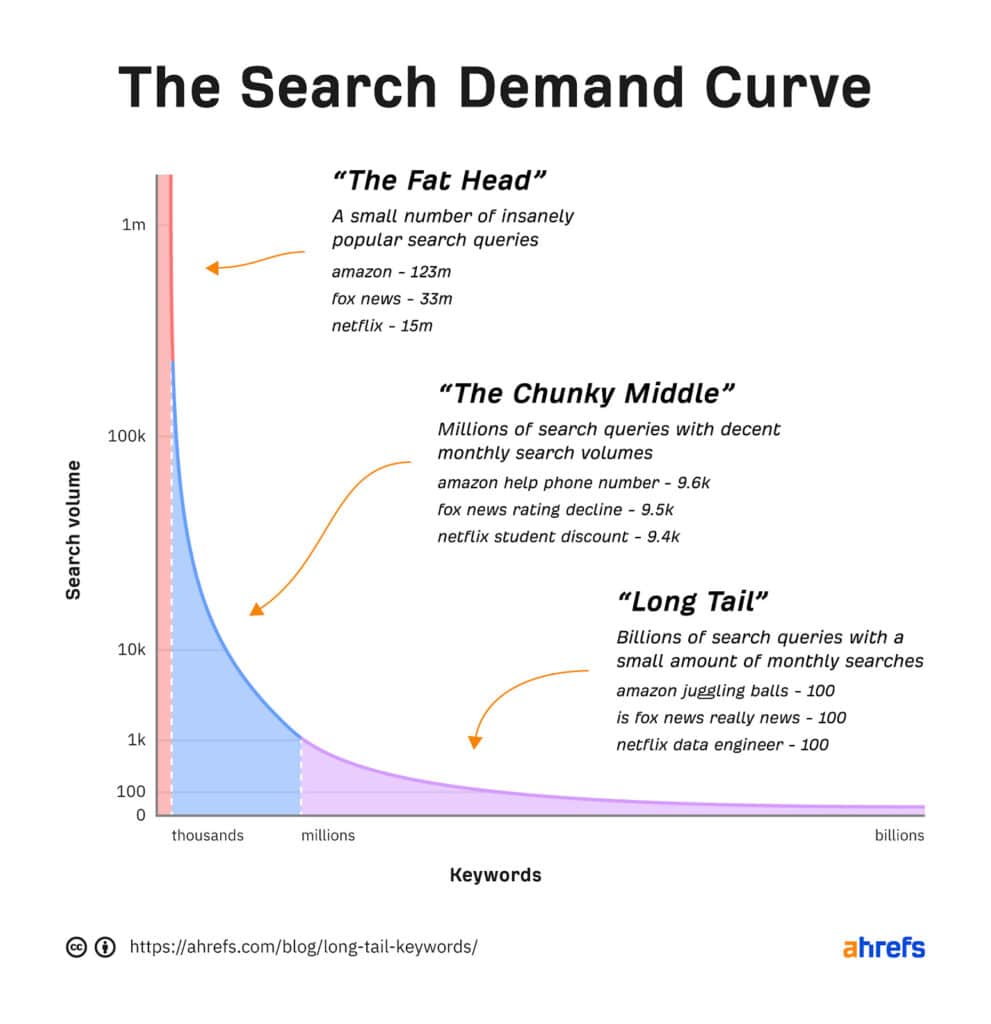SEO? What’s that?
Search Engine Optimization, or SEO for short, is a critical aspect of website design and development. Essentially, SEO is when you optimize your website to rank higher in search engine results, making it more visible to potential customers. In this SEO for beginners guide, we break down the different components of SEO which provides a starting point for implementing an effective SEO strategy for your site.
Keyword Research
Keyword research involves identifying the keywords and phrases that your audience is searching for. Then optimizing your website to rank for those keywords. This research can be done manually or by using tools such as Google Keyword Planner, SEMrush, and Ahrefs. These tools can provide information on search volume, competition, and suggested keywords.
Keywords are broken down into three categories based on their position on the Search Demand Curve.
Head keywords – “Website“: These are typically single words and have a high search volume which makes them hard for you to compete with.
Body (Chunky Middle) – “Responsive website design“: These have a smaller search volume and competition than head keywords but can still be hard for your website to rank for just starting out.
Longtail keywords – “Responsive website design agency in Rhode Island“: These have a small search volume which makes it easier for you to compete with other sites. These can also help you reach the users you want; a user only searching for “responsive website design” probably isn’t looking for an agency in their area.

TIP: When first starting out it is better to try and rank for your local area. If you’re a dog groomer in Providence you should use “dog groomer providence ri” than “dog groomer new england”. The smaller search area and volume give you a better chance at ranking higher. You can read more about local SEO in our SEO Rhode Island Edition guide.
On-Page Optimization
On-page optimization refers to optimizing your website’s pages to rank higher on search engines. This includes optimizing your site’s meta tags, such as the title tag and meta description. It also includes optimizing content and images on the page, proper use of header tags (H1, H2, H3), URL structure, and internal linking can also help with on-page optimization. Title tags and meta descriptions are important because they provide a summary of the page’s content and are displayed in search engine results. Header tags help search engines understand the structure of your webpage. This blog post for example will have the main title as an H1 and each section title as an H2.
Off-Page Optimization
Off-page optimization refers to the optimization of external factors that can affect your website’s ranking. Backlinks are links from other websites that point to your website like social media, blog posts, and online reviews. The higher-ranked websites that link to your site, the more likely your website will rank higher in search results.
TIP: It is not good practice to purchase backlinks and any company offering such a service is likely a scam. The best way to get backlinks is organically. Build relationships with quality sites and become an expert in your field. This will naturally make others want to link to your site.
Technical SEO
Technical SEO involves optimizing your website’s technical elements to improve its ability to rank well in search engine results. This includes mobile optimization, site speed, indexability, and accessibility.
Mobile Optimization: Everyone uses mobile devices to visit web pages. So, search engines actually score your site on how it performs on a mobile phone.
Site Speed: A fast-loading site makes users more likely to use and trust the site. Think of the last time you used a slow-loading website, it can be a very frustrating experience.
Indexability: A search engine’s ability to find and index your website. This is what makes things like a sitemap or robots.txt file essential.
Accessibility: “An accessible site is one whose content can be accessed regardless of any user’s impairments and whose functionality can also be operated by the most diverse range of users possible.” – “What is accessibility?”, Rob Dodson. Things like having elements too close together, and not enough contrast between them can negatively impact your site’s score.
You can use websites like PageSpeed or GTMetrix to check the score of your site and identify potential issues.
Measuring and Tracking Results
It’s essential to measure and track the results of your SEO efforts to determine the success of your strategy. This can be done using tools such as Google Analytics, SEMrush, and Ahrefs. These tools provide information on website traffic, backlinks, and search engine rankings. By regularly monitoring your website’s performance, you can identify areas for improvement and make adjustments to your strategy accordingly.
Conclusion
SEO is a complex and ever-changing process. By using the information in this SEO for beginners guide, you can create an effective SEO strategy that will help your website rank higher in search engine results pages. Remember to continually conduct keyword research, optimize both on-page and off-page elements, ensure technical SEO best practices are in place, and regularly measure and track your results. With a solid SEO strategy in place, you can increase your online visibility and drive more traffic to your website even if you are just beginning your SEO journey!
